 |
||
|
|
|
Celebrating the pipe organ, the King of Instruments |
Pipedreams Euro-Tour
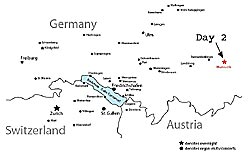 |
April 28 - May 11, 2006
Day 2 - Munich
Frauenkirche,
Saint Franziskus,
Saint Lukas’
 Notes from the Road - travel log, day 2
Notes from the Road - travel log, day 2 Michael Barone’s pictures from the tour
Michael Barone’s pictures from the tour Images from the Frauenkirche, Munich
Images from the Frauenkirche, Munich Images from Saint Franziskus, Munich
Images from Saint Franziskus, Munich Images from Saint Lukas, Munich
Images from Saint Lukas, Munich Day 1 - Saint Peter’s, Saint Michael’s
Day 1 - Saint Peter’s, Saint Michael’s Day 3 - Fürstenfeldbruck & Ottobeuren
Day 3 - Fürstenfeldbruck & Ottobeuren Main Tour Page
Main Tour Page Download the tour book
Download the tour book
Frauenkirche
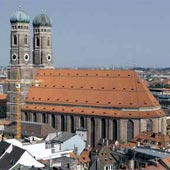 |
The present church is the second one on this site. The first one, Saint Mary’s Church, from 1271, had been enlarged by a Gothic chancel around 1300. The present church has been built in 1468-88. It is the largest Hallenkirche (church with nave and side aisles of equal height) in South Germany, with a length of 330 ft., width of 120 ft. and height of 120 ft. The twin towers, the landmarks of the city of Munich, are crowned by “Welsh coverings” from 1525, instead of the usual spires.
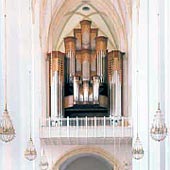 |
The Gallery Organ, with 95 stops on four manuals and pedal, has been built in 1994 by the organ shop of Thomas Jann (Laberweinting). The same company has built the Choir Organ in 1993, with 36 stops on three manuals and pedal.
Links and resources
 Notes from the Road - travel log, day 2
Notes from the Road - travel log, day 2 Images from the Frauenkirche, Munich
Images from the Frauenkirche, Munich Descripion from “Best of Munich”
Descripion from “Best of Munich” Description & 360-degree view of plaza
Description & 360-degree view of plaza Photo of the Jann organ
Photo of the Jann organ Photo of the Jann organ
Photo of the Jann organ Specification in Tour Book
Specification in Tour Book
| Return to top |
Saint Franziskus
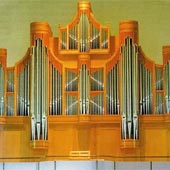 |
The organ has been built in 1993-97 by the Dutch organ company J. L. van den Heuvel from Dordrecht. The instrument is built in the French Symphonic tradition with three manual divisions of 58 notes and a pedal of 30 notes and a total of 51 stops. No stops of previous organs were re-used, also the modern style organ case is new and made of European oak. The dedication was on October 19th 1997.
The internal layout of the instrument is obvious from the front of the case. The Hauptwerk (Great) is placed in the center of the instrument, behind the Hauptwerk the Schwellwerk (Swell). Both divisions are flanked by the splitted Pedalwerk. On the top of the instrument the Positiv is placed. The free standing console is also made of European oak like the organ case. The key action is direct mechanical with electronic couplers. This organ is the first where Van den Heuvel used the proportional coupling system by Syncordia. The electronic stop action is supplied with a memory system.
Links and resources
 Notes from the Road - travel log, day 2
Notes from the Road - travel log, day 2 Images from Saint Franziskus, Munich
Images from Saint Franziskus, Munich Find detailed organ specifications in our Tour Book
Find detailed organ specifications in our Tour Book
| Return to top |
Saint Lukas’Church
The Lutheran Parish Church Saint Lukas, located directly at the banks of the river Isar, has been built by the architect Albert Schmidt in 1893-1896. In Munich, Saint Lukas is the only evangelical parish church in the style of the Historicism that is completely preserved. The architect applied pre-reformatorial styles, the exterior shows Roman forms, the interior is orientated at
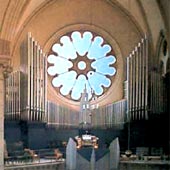 |
The gallery organ was built in 1932 by Steinmeyer & Co. from Oettingen. It replaced an older small instrument on the gallery above the main entrance. It has 67 speaking stops on four manuals and pedal, with electro-pneumatic actions. Minor changes have been made in 1967 (Steinmeyer) and 1987 (Münchner Orgelbau WRK). In 2002, in the course of restoring the west rose-window, the instrument has been renovated and cleaned by the company Frenger & Eder. The specification has been designed primarly still under the influences of the organ reform movement, but there are still some Romantic stops evident. The wide facade has been designed by Professor G. Bestelmeyer (Munich). This organ is the largest one within all Lutheran churches in Munich.
Links and resources
 Notes from the Road - travel log, day 2
Notes from the Road - travel log, day 2 Images from Saint Lukas, Munich
Images from Saint Lukas, Munich Find detailed organ specifications in our Tour Book
Find detailed organ specifications in our Tour Book
| Return to top |


